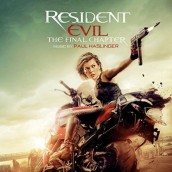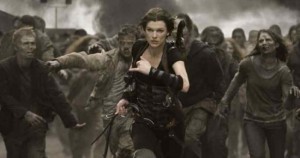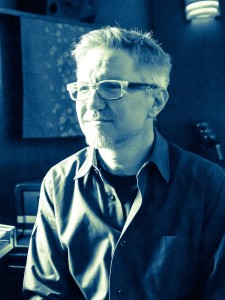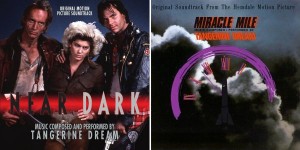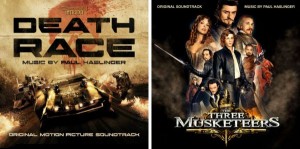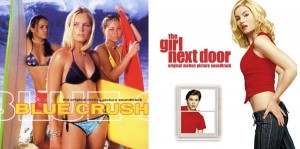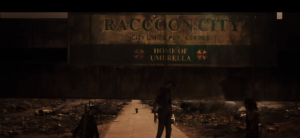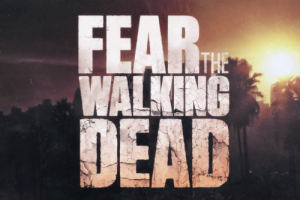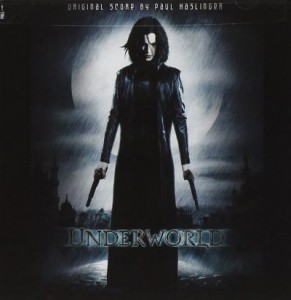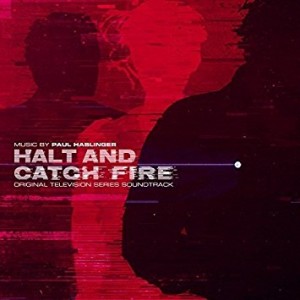When synth retro is all the rage in today’s scoring scene with the likes of STRANGER THINGS and IT FOLLOWS, Paul Haslinger can count himself as one of the O.G. genre gangsters whose exciting music for creatures, gunplay and kick-ass heroes has never stopped mutating. An Austrian bandmate in the seminal progressive synth-rock group Tangerine Dream during such seminal soundtrack likes as NEAR DARK and MIRACLE MILE, Haslinger immigrated to Hollywood with a prolifically successful scoring career. He’d venture from the cool, teen-centric electronic grooves of such scores as CHEATERS, CRAZY / BEAUTIFUL and BLUE CRUSH to a career-making partnership with the vampiric Lycan slayer Selene on the first UNDERWORLD. With grooves as darkly enticing and propulsively exciting as the cat-suited death dealer, Haslinger became a prolific gunsmith for such action thrillers as INTO THE BLUE, CRANK and SHOOT ‘EM UP, as well as rhythm-driven gamework for RAINBOW SIX, NEED FOR SPEED and WOLVERINE among his other UNDERWORD entries.
One particular partnership where Haslinger has really been able to apply pedal to metal is with filmmaker Paul W.S. Anderson, a collaboration which roared out of the gate with the gnarled, bloodily exciting industrial music for 2008’s DEATH RACE, their music making a left turn with a steampunk approach to Anderson’s enjoyable take on THE THREE MUSKETEERS. But if there’s one franchise that Anderson has made his bones on, then it’s RESIDENT EVIL, a crazed take of the Konami videogame that’s meshed sci-fi, horror and kill-crazy excitement over the course of five films as Alice (dynamically played by Anderson’s wife Mila Jovovich) has somehow survived every monstrosity thrown at her by The Umbrella Corporation, whose bottom line is humanity’s destruction.
Now the journey that Alice’s began though a hellish wonderland in 2004 conclusively reaches the heart of Umbrella after six films with the RESIDENT EVIL: THE FINAL CHAPTER. Taking over the wheel from such previous composers as Marco Beltrami, Marilyn Manson, Charlie Clouser and Tomandandy, Haslinger proves to be his own, ass-kicking musical man for one of sci-horror’s most popular heroines. With a mean industrial edge and reflective piano emotion for a woman who’s suffering had made her stronger, Haslinger blasts his way through the beast-filled Raccoon City with equal parts atmosphere and action, creating an elegiac, epic sense of closure to the most successful game-to-film series. His samples buzz with the evil cyber machinations of Umbrella as organic strings plays the human determination of Alice and her avengers, all roads leading to blazing, darkly heroic climax that gives the ultimate survivor her musical due in style. But perhaps more than anything on his first, and last RESIDENT entry, Paul Haslinger continues to prove that he knows his way around the cutting edge of electronic, sample-propelled music – especially when delivering the rocking, heroic hurt to the zombie apocalypse.
ASSIGNMENT X: As a budding musician, what importance did Tangerine Dream have for you? And what led you play for them?
HASLINGER: When I grew up, Tangerine Dream was one of those big, established acts. As a keyboard player, of course I loved all the outlandish equipment they were using, and together with Kraftwerk, they were a major influence on anybody working in music around that time. At the end of 1985, Edgar Froese and Chris Franke were looking to fill Johannes Schmoelling´s spot for an upcoming UK tour. Edgar had a studio in Austria, and he was auditioning various session players from Vienna. I was one of the lucky ones, and apparently made a good enough impression to be asked to join them for the tour and subsequently stay on for the next album (Underwater Sunlight) to become a fulltime member. At the age of 23, it was a dream come true (no pun), allowing me to leave Austria and to see the world, and to make a living making music.
AX: What was the team composing process like with Tangerine Dream? And how would you describe your contribution to such scores as NEAR DARK and MIRACLE MILE?
HASLINGER: Tangerine Dream in those days already was a modular band: every member had their own studio, and we would develop ideas and sketches, play them for each other and eventually work on overdubs and mixes together. As such, working on an album was no different than working on a film. And it was in this type of collaborative setting, that both NEAR DARK and MIRACLE MILE were created. NEAR DARK was written and recorded in Berlin, with Kathryn Bigelow attending the final mix sessions. I remember her notion of a ‘Vampire Western’, which together with the excellent cinematography and performances, proved to be very inspiring to us. MIRACLE MILE was written and recorded in Edgar’s studio in Austria. This place sat on a lake, in relative isolation. The filmmaker Steve De Jarnatt came to spend a couple of weeks with us there, finishing the score. And I attribute this atmosphere, no distractions whatsoever, for some of the qualities and the peculiarities of this score: a more stripped down, simple approach, which I would consider one of Tangerine Dream’s highlights from this era.
AX: What was it like to strike out on your own and move to LA? And how did you make the break into solo composing here?
HASLINGER: I left TD in 1990, mostly because I felt we were getting trapped in predictable patterns and the musical direction of the band wasn’t heading in the right direction. LA was a place I was very familiar with, from being on tour and spending some time scoring films in town. It seemed to have a lower stress level than other cities I had been to (it still does) and I knew a lot of musician friends and like-minded people in town. It was my second musical awakening. Tangerine Dream helped me to get out of Austria, my relocation to Los Angeles helped me to see a larger, musical world. It was during this time I discovered music from around the planet, and the albums I released in the 90s reflect this musical exploration.
On the side, I also did a number of scoring projects, working in the experimental field (with Siggraph and various visual artists: Frank Foster, Brummbaer), and collaborating with my former bandmate Chris Franke on the cult-TV show BABYLON 5. In 1997 I was introduced by my friend Brian Williams to composer Graeme Revell. Graeme was looking for a programmer to join his team, and we ended up working together for a few years on films such as CHINESE BOX, THE NEGOTIATOR, THE SEIGE, TOMB RADIER and BLOW. It was during this time, that I started developing a stronger interest in film scoring, seeing how much fun and creative opportunity was at stake in each of Graeme’s projects. Being part of Graeme’s team certainly also helped bringing me to the attention of various studio executives and agents.
AX: You started off with coo, youth-oriented scores for CHEATERS, CRAZY / BEAUTIFUL, BLUE CRUSH and THE GIRL NEXT DOOR. Did you particularly enjoy scoring for a “lighter” beat and atmosphere-driven films?
HASLINGER: When you start out, you don’t really pick the films you score. You are just happy you get to score one at all. So there was never a conscious decision to score any type of film. Those were just the ones that were offered to me. As with any composer starting out, I had some notions of what I thought could be done differently in film scoring, and in particular the use of musical language – more of a connection between what’s happening in the score and what’s happening with the songs. In simple terms, I was hoping to translate some of my album production studio experience directly into film scoring. And those first films were my first attempt to do so.
AX: How did you like scoring the particularly eccentric action of CRANK and SHOOT ‘EM UP, and do you think body count pictures like that lead you down the road to horror?
HASLINGER: I never made that connection. But now that you mention it – hmmm!? I think both CRANK and SHOOT ‘EM UP were extremely stylized films (just as “Underworld” had been) and they required music writing as much as music design. A rollercoaster can’t be accidental. It has to be planned and structured so the ride can be as much fun as possible. That was the job on these films, and to at least some degree, I believe we succeeded. At the start of the score for SHOOT ‘EM UP, I booked a studio in LA for a week, hired a group of my favorite musicians and pre-recorded a catalog of general ideas I had developed. It was an intense week, with different ensembles playing every day and night, me yelling out numbers and references and sometime having them play directly against picture. I remember the console was not working very well and the process overall bordered on chaos. But the score found its particular atmosphere and vibe in those sessions, and while not everything got used obviously, it did set the tonal and musical character of the score and parts of these sessions were used across the entire film.
AX: Tell us about working with Paul Anderson on DEATH RACE and THREE MUSKETEERS, and how your sensibilities vibe together, whether it ranged from industrial to making a classical adventure sound hip?
HASLINGER: Paul is one of a handful of directors I’ve worked with for some time and have become friends with. We obviously enjoy working together and share what I would call an obsessive streak. Paul invests himself 200% into his projects, and I presume he senses a similar predisposition with me. As a result, the work is always intense and never boring. DEATH RACE started out as the musically unwinnable battle against car-engines, tire-squeals and machine gun fire. It was probably the loudest movie anybody ever mixed. My ears are still bleeding. MUSKETEERS was a different story. Part of the appeal was that I had never done anything like this before. And once I started running with it, I really enjoyed where it took me. I recorded and mixed in Berlin, it was quite a ride.
AX: How do you think that scoring many entries of the UNDERWORLD saga, with its “death dealer” female hero, set you up to handle Alice for RESIDENT EVIL?
HASLINGER: There is an obvious connection between these two franchises. They both started around the same time (2002-2003). They both became extremely popular and successful, despite much critical scorn. And they filled a demand for films that reflect changes in popular culture, specifically the influence of graphic novels and video games. They both feature a female heroine, and make her the centerpiece of the film and the entire series. So yes, I was generally familiar with the turf we were playing on. And yet, part of the appeal to score RESIDENT EVIL was precisely that it was NOT another UNDERWORLD film. This was the chance to use technique and skill but to apply it in a different context, and thereby a better chance to mix it up and challenge myself to a different approach.
AX: Given RESIDENT EVIL’s crazy mythology and mash of genres, did you bone up on the movies, or video games beforehand as well?
HASLINGER: I sure did. That’s part of the fun of the job: I get to do “research” and learn the landscape. Paul had already asked me to work on RESIDENT EVIL 5 (which then did not happen due to some tax and scheduling issues) so I was quite familiar with the general landscape and evolution leading up to the final film. But once I saw some of the footage from South Africa, I knew the look and feel of the film would be quite different from the previous installments.
AX: What’s it like to come in for the first time on the long-awaited last chapter of a popular series like this? And does that place greater importance on the score to pay off?
HASLINGER: At the end of the day, it’s still a film that needs some music. Yes, there should be a feeling of finality, and yes, it’s important to reflect major character developments, like the re-appearance of the Red Queen. But it is still constructed as a ride, and I am responsible to help make those 90 minutes as engaging, entertaining and moving as possible.
AX: How do you think your music embodies Alice’s attitude as she reaches the end of her quest to destroy Umbrella?
HASLINGER: I believe people relate to Alice as a tragic hero who will also kick some ass. And I would describe those two qualities as the starting point for the music. The film has a certain sweep, a ‘final chapter’ atmosphere, which I tried to reflect in the music. She is coming to ‘the end of her story’ with all the fury, fight and emotion that only Alice can muster.
AX: When it comes to the villains, what were your ideas for the high-tech Umbrella Corporation and its minions?
HASLINGER: Always fun! Villains are the best! Give me a good villain and the half of the score writes itself! Iain Glen gives such a marvelous performance. I cannot thank him enough! The Umbrella theme has generally been the dark undercurrent of the series. I embraced the opportunity to bring their long developing story to its conclusion in this film.
AX: Could you talk about jumping from the score’s metal energy to its epic orchestrations that capture the scope of Alice’s world?
HASLINGER: One of my ideas was to contrast some industrial, harder hitting elements, with more elegiac, choral-type movements. And to drive the tension between these two opposites further than I had done in previous scores.
AX: There are some particularly gnarly, monstrous grooves to your RESIDENT EVIL score. What instruments and samples went into the score?
HASLINGER: There is a lot of programming and studio production that went into the rhythm design on this particular score. We know it had to fit with a lot of sound effects, a cutting style that was based on commercials and a story that was nonlinear in nature. We also did a full day of live percussion recordings. For the processing, I went back to some of the type of dirty/edgy processing I used on the first UNDERWORLD score. Whenever the fabric of a score becomes too complex, I find it necessary to “dirty up” the sound and make it less pristine.
AX: Having scored movies where the suspense-horror is more front-and-center like PROM NIGHT and VACANCY, what’s it like to add the demands of the action genre into that equation with RESIDENT EVIL?
HASLINGER: Hopefully the best of both worlds? I think what we are talking about is not limited to a traditional genre, but in a way has created its own genre. These are big films aimed at a demographic whose point of reference are graphic novels and previous films like THE CROW, DARK CITY and THE MATRIX, RESIDENT EVIL was not the first of these films, but it was an important step in the development of this particular sub-genre. And the music just needs to fit the particular experience it tries to convey. “Over the top” is part of the fabric.
AX: As a composer who was there for the seminal synth sound of Tangerine Dream, is it surreal to be watching a rebirth for that genre of music with such scores as IT FOLLOWS and STRANGER THINGS?
HASLINGER: I am good friends with Kyle and Michael and have a lot of respect for Richard Vreeland, who scored IT FOLLOWS as Disasterpeace. They are all music geeks (like myself) and have taken something they love and put their own spin on it. History allows perspective, and we have come far enough with electronic music that this re-imagining of previous territory can become the breeding ground for new ideas and interpretations. All power to them, and I hope many more musicians will follow their lead.
AX: On that note, what’s it like to go back to your old-school rhythmic roots when scoring the show HALT AND CATCH FIRE?
HASLINGER: There was certainly a time-machine aspect to it, but I also simply liked the show, the story, and welcomed the chance the particular setting offered for inspired music choices. It certainly was fun to dive back in and to mix up the elements a little – leaving out what I’d rather not hear again, and expanding on the nuggets, which I thought, stood the test of time. The music is an essential part of the storytelling on this show, and as such, obviously, it has been and is still is a wonderful opportunity. Much credit goes to the shows creators, Christopher C.Rogers and Christopher Cantwell, the music supervisor Thomas Golubic and the show’s producer, Melissa Bernstein.
AX: You’ve also become part of AMC’s hugely popular franchise with FEAR THE WALKING DEAD. How important was it for you that the show has its own musical identity that would set it apart from THE WALKING DEAD?
HASLINGER: It was clear pretty early on that they wanted a different show with a different sound. Yes, there are walkers in both shows and the setting is that of a post-apocalyptic world. But the cast and constellation of characters, the fabric of the show, is fairly distinct from TWD. Therefore my approach was to write music from scratch, as if the other show did not exist. To allow the show to find its own sound and musical setting.
AX: Would you say that scoring movies like RESIDENT EVIL are like doing rock operas for you in terms of their relentless, metal-powered drive?
HASLINGER: The combination of edgy, industrial elements with orchestra is always tricky, but in a general sense I am just fitting music to the landscape the picture provides. If the action gets heavy, the music will reflect that, be it in synchronicity or as a counterpoint. And the choreography of the film, the pacing, the energy and the general flow has to be the starting point for any musical approach.
AX: Having scored so many films full of hybrid creatures, where do you see your own mad experiments at fusing orchestra, orchestral emulation and synth sampling going next?
HASLINGER: I guess we’ll have to wait and find out! In all my film/tv/vg work, I always respond to the project, obviously. The project inspires the musical ideas, and part of the fun is to never know where it will take me. The biggest challenge, I believe, is to stop the constant flood of input and options one faces and to decide and stay on a particular approach and idea. We used to face natural limitations. Today we have to create artificial restrictions and limitations, to have a chance at focus and effect.
AX: What do you think makes a “videogame” movie and score like RESIDENT EVIL: THE FINAL CHAPTER work in the end?
HASLINGER: They put people on a ride, and if by the end of it they enjoyed this particular ride, then the film was effective. We live by experiences, and these films try to provide one particular experience. The more films and the more rides, the more difficult it is to come up with “yet another ride,” so there will always be this challenge. But with an established fan-base, as with “Resident Evil” and UNDERWORLD fans, we also owe it to that audience to deliver, to go above and beyond and to let them enjoy the best RESIDENT EVIL film yet. And that’s what we aim for.
Take on The Umbrella Corporation with Alice and Paul Haslinger when RESIDENT EVIL: THE FINAL CHAPTER opens on January 27th, with its score available on Lakeshore Records HERE
Hear another ass-kicking heroine as Paul Haslinger ventures to his UNDERWORLD scores HERE
HALT AND CATCH FIRE with Paul Haslinger HERE
Visit Paul Haslinger’s website HERE
AGREE? DISAGREE? LET YOUR VOICE BE HEARD – COMMENT BELOW
Follow us on Twitter at ASSIGNMENT X
Like us on Facebook at ASSIGNMENT X
Article Source: Assignment X
Article: Interview with RESIDENT EVIL: THE FINAL CHAPTER composer Paul Haslinger
Related Posts:




